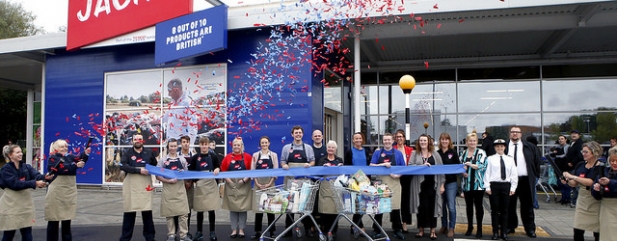Archived article
Please note that tax, investment, pension and ISA rules can change and the information and any views contained in this article may now be inaccurate.
What does the launch of Jack’s really mean for Tesco shareholders?

One week on from the very high profile launch of Tesco’s (TSCO) new value chain, Jack’s, and the stock market appears to have given a thumbs-up to the venture, judging by how the shares have risen nearly 3% since the launch on 19 September.
Now the hype has died down, we take a closer look at what Jack’s could really mean for Tesco, from an investment perspective, and whether it is big news or simply a tiny part of the giant cog that is the £23.4bn company.
WHY HAS IT LAUNCHED JACK’S?
Tesco is attempting to tackle the rise and rise of German discounters Aldi and Lidl through the opening of its own discount store.
Over the coming six months, Britain’s biggest retailer will launch 10-15 Jack’s stores in the UK, the first two having already opened in Chatteris and Immingham, with the stores including a mix of new sites, buildings adjacent to existing Tesco stores and a small number of converted Tesco supermarkets.
Seemingly aping the model of the aforementioned German upstarts, Jack’s will operate a business model designed to keep costs low and prices down for hard-pressed shoppers.
This no-fuss approach means a simplified product range, no fancy fixtures or fittings and no added extras.
HOW DOES JACK’S FIT IN THE WIDER CORPORATE STRATEGY?
Amid ultra-competitive market conditions, Tesco and its supermarket rivals are struggling to get their sales growth to exceed the pace of food price inflation, while rampaging Aldi and Lidl continue to grow fast.
Having bolstered its position in the rapidly-evolving UK retail sector via the acquisition of Booker, Tesco’s launch of Jack’s is obviously a fresh attempt to bat off the threat posed by the German budget insurgents.
Yet there is some disappointment in that the initial roll-out isn’t more ambitious. Are 15 stores enough to put much of a dent in the 13.1% combined market share of Aldi and Lidl, as chronicled by the latest Kantar Worldpanel supermarket share data (18 Sep), covering the 12 weeks to 9 September?
Ominously for their rivals, Aldi and Lidl, who together have over 1,300 stores across the country, continued to outpace the market in the period, growing sales by 13.9% and 8.3% respectively.
There are also concerns that Tesco, still very much the dominant UK player with 27.4% share while the Competition & Markets Authority (CMA) pores over the proposed merger of J Sainsbury (SBRY) and ASDA, could merely end up cannibalising its own shopper base, although it is better to cannibalise your own sales than have a rival do it for you.
A PIMPLE ON AN ELEPHANT?
An additional key risk is that Tesco may struggle to operate this different business model alongside the established core business, with management becoming distracted by the new and exciting launch.
And as Shore Capital, which recently attended the grand opening of Jack’s, points out: ‘The store is a pimple on the vast Tesco UK and group “elephant”, so a sense of perspective is necessary.’
It adds: ‘We struggle with the strategic importance of Jack’s beyond its clear sign that management is out of fix mode and the cost engineering clearly evident.
‘We do ask the open question as to whether or not Jack’s could get under the skin of Aldi and Lidl and maybe destabilise industry gross margins with Tesco management claiming that its LAD (limited assortment discounter) will be cheaper.’
Keep in mind that for the current year to February 2019, Shore forecasts an increase in Tesco’s adjusted pre-tax profit from £1.305bn to £1.903bn on sales of £63.62bn (2018: £57.49bn), so a 15-store strong Jack’s estate would be small beer for the groceries behemoth.
Moreover, the broker senses that Jack’s is ‘very proprietary’ and is taking up a reasonable amount of senior management time, although Shore insists it is ‘a modest trial that does not “bet the bank” and falls within current capital expenditure guidance’.
SOUNDS FAMILIAR?
Patrick O’Brien, UK retail research director at GlobalData, reminds investors that: ‘Sainsbury’s tried something similar in 2014 with its Netto joint venture, only to close two years later having only opened 16 stores.
‘The secrecy and fanfare surrounding Jack’s launch points to a much more ambitious attack but its plans to open 10 to 15 stores next year are surprisingly tame.
‘As Tesco targets a return to a 4% profit margin by 2020, opening at a faster rate would make this more difficult and also risk cannibalising sales.
‘After years of battling accounting scandals and pulling back from some international markets, Tesco is at least back on the front foot and taking the battle to the discounters. But we expected a more aggressive store opening schedule and Aldi and Lidl are unlikely to be too concerned about this opening salvo.’
NEXT MOVE: EUROPE MERGER?
Chatter about potential merger talks between French supermarkets Casino and Carrefour will no doubt lead to speculation in the UK about whether Tesco might be a better partner for Carrefour. After all, the two companies formed a commercial agreement during the summer.
Tesco and Carrefour have a combined 8% share of the western European grocery market – greater than either Aldi or Lidl.
Tesco may want to strengthen its UK business before considering any such deal, but you can be sure that market will continue to speculate on its next move, now that Jack’s has signalled a return to strategic growth for the business. (JC)
Important information:
These articles are provided by Shares magazine which is published by AJ Bell Media, a part of AJ Bell. Shares is not written by AJ Bell.
Shares is provided for your general information and use and is not a personal recommendation to invest. It is not intended to be relied upon by you in making or not making any investment decisions. The investments referred to in these articles will not be suitable for all investors. If in doubt please seek appropriate independent financial advice.
Investors acting on the information in these articles do so at their own risk and AJ Bell Media and its staff do not accept liability for losses suffered by investors as a result of their investment decisions.
Issue contents
Big News
- Brexit tensions stoked as political storm clouds gather
- BAE Systems finally gets jet fighter green light
- Will Aston Martin shares be a luxury you can’t afford?
- Sit tight with Randgold as it may attract a counter bid to Barrick's merger proposal
- Woodford Patient Capital springs back to life
- Why the potential Uber-Deliveroo deal could be a ‘terrifying’ development for Just Eat

 magazine
magazine









